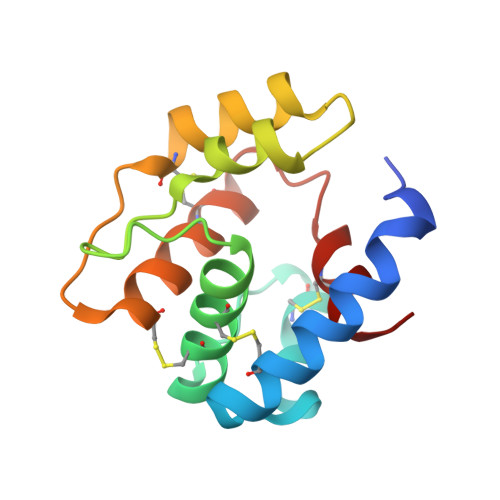The Crystal Structure of Odorant Binding Protein 7 from Anopheles gambiae Exhibits an Outstanding Adaptability of Its Binding Site.
Lagarde, A., Spinelli, S., Tegoni, M., He, X., Field, L., Zhou, J.J., Cambillau, C.(2011) J Mol Biol 414: 401-412
- PubMed: 22019737
- DOI: https://doi.org/10.1016/j.jmb.2011.10.005
- Primary Citation of Related Structures:
3R1O, 3R1P, 3R1V - PubMed Abstract:
Anopheles gambiae (Agam) targets human and animals by using its olfactory system, leading to the spread of Plasmodium falciparum, the malaria vector. Odorant binding proteins (OBPs) participate to the first event in odorant recognition and constitute an interesting target for insect control. OBPs interact with olfactory receptors to which they deliver the odorant molecule. We have undertaken a large-scale study of proteins belonging to the olfactory system of Agam with in mind of designing strong olfactory repellants. Here, we report the expression, three-dimensional structures and binding properties of AgamOBP07, a member of a new structural class of OBPs, characterized by the occurrence of eight cysteines. We showed that AgamOBP07 possesses seven α-helices and four disulfide bridges, instead of six α-helices and three disulfide bridges in classical OBPs. The extra seventh helix is located at the surface of the protein, locked by the fourth disulfide bridge, and forms a wall of the internal cavity. The binding site of the protein is mainly hydrophobic, elongated and open and is able to accommodate elongated ligands, linear or polycyclic, as suggested also by binding experiments. An elongated electron density was observed in the internal cavity of the purified protein, belonging to a serendipitous ligand. The structure of AgamOBP07 in complex with an azo-bicyclic model compound reveals that a large conformational change in the protein has reshaped its binding site, provoking helix 4 unfolding and doubling of the cavity volume.
Organizational Affiliation:
Architecture et Fonction des Macromolécules Biologiques, UMR 6098 CNRS and Universités of Marseille, 13288 Marseille cedex 9, France.















